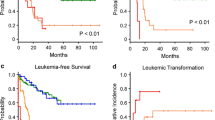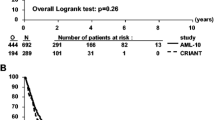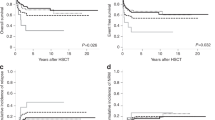Abstract
Clinical trials and treatment guidelines for myelodysplastic syndrome depend on several prognostic scoring systems to stratify patients by risk. These include different variables: the degree of cytopenia, percentage of bone marrow blasts, and cytogenetics. Little is known about the impact of bone marrow blasts in patients with adverse cytogenetics. In this retrospective study, we analyzed 536 patients with high-grade myelodysplastic syndrome to examine the differences in survival for patients with different percentages of bone marrow blasts. The median overall survival in patients with ≥ 5% marrow blasts was not statistically different from that for patients with < 5% marrow blasts; however, the former group had a higher risk of progression to acute myeloid leukemia (p < 0.001). Therefore, cytogenetics is the most important factor in our prognostic tools to determine survival outcomes for patients with myelodysplastic syndrome, and patients with high-risk disease have poor prognosis irrespective of their marrow blasts percentage.




Similar content being viewed by others
References
Greenberg PL, Tuechler H, Schanz J, Sanz G, Garcia-Manero G, Solé F, Bennett JM, Bowen D, Fenaux P, Dreyfus F, Kantarjian H, Kuendgen A, Levis A, Malcovati L, Cazzola M, Cermak J, Fonatsch C, le Beau MM, Slovak ML, Krieger O, Luebbert M, Maciejewski J, Magalhaes SM, Miyazaki Y, Pfeilstöcker M, Sekeres M, Sperr WR, Stauder R, Tauro S, Valent P, Vallespi T, van de Loosdrecht A, Germing U, Haase D (2012) Revised international prognostic scoring system for myelodysplastic syndromes. Blood 120(12):2454–2465
Arber DA, Orazi A, Hasserjian R, Thiele J, Borowitz MJ, le Beau MM, Bloomfield CD, Cazzola M, Vardiman JW (2016) The 2016 revision to the World Health Organization classification of myeloid neoplasms and acute leukemia. Blood 127(20):2391–2405
Vardiman JW, Thiele J, Arber DA, Brunning RD, Borowitz MJ, Porwit A, Harris NL, le Beau MM, Hellström-Lindberg E, Tefferi A, Bloomfield CD (2009) The 2008 revision of the World Health Organization (WHO) classification of myeloid neoplasms and acute leukemia: rationale and important changes. Blood 114(5):937–951
NCCN. The National Comprehensive Cancer Network for Myelodysplastic Syndrome Version 2.2019. 2019; Available from: https://www.nccn.org/
Sperling AS, Gibson CJ, Ebert BL (2016) The genetics of myelodysplastic syndrome: from clonal haematopoiesis to secondary leukaemia. Nat Rev Cancer 17:5
Steensma DP (2015) Myelodysplastic syndromes: diagnosis and treatment. Mayo Clin Proc 90(7):969–983
Steensma DP (2018) Myelodysplastic syndromes current treatment algorithm 2018. Blood Cancer Journal 8(5):47
Fenaux P, Kiladjian JJ, Platzbecker U (2019) Luspatercept for the treatment of anemia in myelodysplastic syndromes and primary myelofibrosis. Blood 133(8):790–794
Aleshin A, Greenberg PL (2018) Molecular pathophysiology of the myelodysplastic syndromes: insights for targeted therapy. Blood Advances 2(20):2787–2797
DiNardo CD et al (2016) Interactions and relevance of blast percentage and treatment strategy among younger and older patients with acute myeloid leukemia (AML) and myelodysplastic syndrome (MDS). Am J Hematol 91(2):227–232
Braulke F, Platzbecker U, Müller-Thomas C, Götze K, Germing U, Brümmendorf TH, Nolte F, Hofmann WK, Giagounidis AA, Lübbert M, Greenberg PL, Bennett JM, Solé F, Mallo M, Slovak ML, Ohyashiki K, le Beau MM, Tüchler H, Pfeilstöcker M, Nösslinger T, Hildebrandt B, Shirneshan K, Aul C, Stauder R, Sperr WR, Valent P, Fonatsch C, Trümper L, Haase D, Schanz J (2015) Validation of cytogenetic risk groups according to International Prognostic Scoring Systems by peripheral blood CD34+FISH: results from a German diagnostic study in comparison with an international control group. Haematologica 100(2):205–213
Author information
Authors and Affiliations
Corresponding author
Ethics declarations
Conflicts of interest
The authors declare that they have no conflict of interest.
Ethical approval
This article does not contain any studies with human participants or animals performed by any of the authors.
Informed consent
This is a retrospective study, approved by the Mayo Clinic IRB and deemed minimal risk so informed consent waiver was obtained from the Mayo Clinic IRB.
Additional information
Publisher’s note
Springer Nature remains neutral with regard to jurisdictional claims in published maps and institutional affiliations.
Rights and permissions
About this article
Cite this article
Alkharabsheh, O., Patnaik, M.M., Gangat, N. et al. Impact of marrow blasts percentage on high-grade myelodysplastic syndrome assessed using revised international prognostic scoring system. Ann Hematol 99, 513–518 (2020). https://doi.org/10.1007/s00277-020-03917-7
Received:
Accepted:
Published:
Issue Date:
DOI: https://doi.org/10.1007/s00277-020-03917-7




